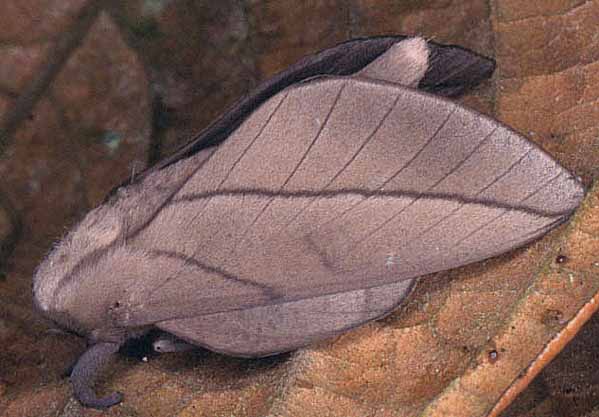Citioica anthonilis
|
|
Updated as per Lemaire's Ceratocampinae 1988, September 26, 2006
SHILAP: Notes on some Saturniidae from Albania (Caqueta Department), Racheli and Vinciguerra, 2005
Updated as per communication from Jean Michel Maes (Nicaragua), March 2007
|
Citioica anthonilis
SIH-tee-oy-kuhmmann-thuh-NYE-luhs
(Herrich-Schaeffer, [1854])
Adelocephala

Citioica anthonilis moth courtesy of Leroy Simon.
TAXONOMY:
Superfamily: Bombycoidea, Latreille, 1802
Family: Saturniidae, Boisduval, [1837] 1834
Subfamily: Ceratocampinae, Harris, 1841
was Citioicinae: Travassos & Noronha, 1967
Genus: Citioica Travossos & Noronha, 1965 |
MIDI MUSIC
"WhatAWonderfulWorld"
copyright C. Odenkirk
MIDI CITY
ON.OFF
<bgsound src="world.mid" LOOP=FOREVER>
|
DISTRIBUTION:
The Citioica anthonilis moth,
(wingspan: males: 52-80mm; females: 75-106mm), flies in
Brazil: Alagoas, Para, Mato Grosso,
Minas Gerais, Rio de Janeiro, Sao Paulo, Santa Catarina;
Mexico: Veracruz, Chiapas;
Belize: Cayo, Stann Creek, Toledo;
Guatemala: Zacapa;
(probably
Honduras);
El Salvador: San Salvador;
Nicaragua: Zelaya;
Costa Rica: Heredia;
Panama: Bocas del Toro;
Venezuela: Carabobo, Aragua, Distrito Federal,
Miranda, Monagas, Bolivar;
(probably
Guyana; and
Suriname);
French Guiana: Territoire de I'Inini;
Colombia: Valle, Choco, Territoria Vasquez, Meta,
Caqueta, and probably Amazonas and Putamayo;
Ecuador: Napo, Morona-Santiago and probably
Orellana and Pastaza;
Peru: Junin, San Martin, Huanuco,
Madre de Dios, Cuzco, Puno;
Bolivia: La Paz, Santa Cruz, Cochabamba,
Chuquisaca; and
Paraguay UD:
Canindeyu,
Caaguazu, and probably
Alto Parana,
Caazapa
and Itapua.
This species flies at low elevation.

Citioica anthonilis, September, 2006,
Huanuco Province, Peru, courtesy of
Juan Chavez.
In the male, the dark brown preapical pm line is straight
except for a noticable turn toward the almost straight am line just
before meeting the inner margin.
The postmedian area is darker brown than basal and median areas. The
outer margin is convex, and thin dark wing veins are noticeable. The
basal and median areas are lighter grey-brown. The cell marking is a
thin diffuse brown line.
FLIGHT TIMES AND PREFERRED FOOD PLANTS:
Moths are on the wing in September and February. Citioica
anthonilis larvae feed upon
Robinia pseudoacacia
and Salix capraea.
ECLOSION, SCENTING AND MATING:Citioica anthonilis male copyright Kirby
Wolfe. Females exude a pheromone scent plume into the night sky. Males fly into the wind in a zigzag fashion and use their highly developed
antennae to track the plume and locate the females. Males are considerably smaller than females. | 
|

Citioica anthonilis courtesy of Bernhard Wenczel.
EGGS, LARVAE AND PUPAE:

Citioica anthonilis, third instar, courtesy/copyright
Leroy Simon.

Citioica anthonilis, third instar, courtesy/copyright
Leroy Simon.

Citioica anthonilis larva copyright Kirby
Wolfe.

Citioica anthonilis larva copyright
Franz Ziereis.

Citioica anthonilis Claude Lemaire, on my home computer only.
Larvae show considerably variation. There is an
almost black form with a double, white spiracular line and
yellow at the base of the each scoli.
With regard to the differences between the Kirby Wolfe larval image and
the Franz Ziereis image, which is very similar to Lemaire's image,
Kirby writes, "When I sent Lemaire a photo
of my Citioica anthonilis larva, he was extremely surprised,
but neither he nor I were able to find any differences in the adults
from his and my rearings. So are they different species? Who's to
say? Based on the color of the larva? Larval color can be
geographically variable in many species of saturniids. This, I
believe, is just an extreme example. Or maybe they're different
identical species?? Go figure."
I am just a neophyte compared to Kirby Wolfe and Claude Lemaire, but
I would not be surprised to some day learn that the larvae are of
different species. I have not seen larvae of any of the
Oiticella (very different geographic range), but the moths
seem quite similar. Kirby's image
also reminds me of some of the Adeloneivaia and
Syssphinx larvae, but larvae of many of the Ceratocampinae
genera are similar.
It should be noted that Kirby's image is from Mexico.
Larval Food Plants
Listed below are primary food plant(s) and alternate food plants listed in Stephen E.
Stone's Foodplants of World Saturniidae. It is hoped that this
alphabetical listing followed by the common name of the foodplant will
prove useful. The list is not exhaustive. Experimenting with closely
related foodplants is worthwhile.
Robinia pseudoacacia.....
Salix capraea
| Black locust/false acacia
Sallow/Goat willow
|
Return to Citioica Index
Return to Main Index








